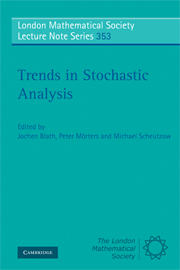Book contents
- Frontmatter
- Contents
- Preface
- Heinrich von Weizsäcker's students
- Heinrich von Weizsäcker's publications
- I Foundations and techniques in stochastic analysis
- II Construction, simulation, discretization of stochastic processes
- III Stochastic analysis in mathematical physics
- IV Stochastic analysis in mathematical biology
- 12 Measure-valued diffusions, coalescents and genetic inference
13 - How often does the ratchet click? Facts, heuristics, asymptotics
Published online by Cambridge University Press: 05 March 2012
- Frontmatter
- Contents
- Preface
- Heinrich von Weizsäcker's students
- Heinrich von Weizsäcker's publications
- I Foundations and techniques in stochastic analysis
- II Construction, simulation, discretization of stochastic processes
- III Stochastic analysis in mathematical physics
- IV Stochastic analysis in mathematical biology
- 12 Measure-valued diffusions, coalescents and genetic inference
Summary
Abstract
The evolutionary force of recombination is lacking in asexually reproducing populations. As a consequence, the population can suffer an irreversible accumulation of deleterious mutations, a phenomenon known as Muller's ratchet. We formulate discrete and continuous time versions of Muller's ratchet. Inspired by Haigh's (1978) analysis of a dynamical system which arises in the limit of large populations, we identify the parameter γ = Nλ/(Ns · log(Nλ)) as most important for the speed of accumulation of deleterious mutations. Here N is population size, s is the selection coefficient and λ is the deleterious mutation rate. For large parts of the parameter range, measuring time in units of size N, deleterious mutations accumulate according to a power law in Nλ with exponent γ if γ ≥ 0.5. For γ < 0.5 mutations cannot accumulate. We obtain diffusion approximations for three different parameter regimes, depending on the speed of the ratchet. Our approximations shed new light on analyses of Stephan et al. (1993) and Gordo and Charlesworth (2000). The heuristics leading to the approximations are supported by simulations.
Introduction
Muller's ratchet is a mechanism that has been suggested as an explanation for the evolution of sex [13]. The idea is simple; in an asexually reproducing population chromosomes are passed down as indivisible blocks and so the number of deleterious mutations accumulated along any ancestral line in the population can only increase.
- Type
- Chapter
- Information
- Trends in Stochastic Analysis , pp. 365 - 390Publisher: Cambridge University PressPrint publication year: 2009
- 12
- Cited by



